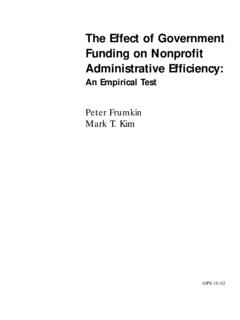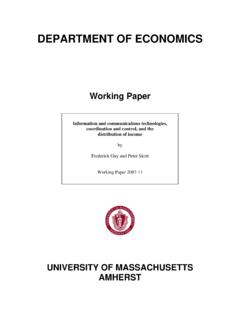Transcription of Vietnam’s Infrastructure Constraints - Ash Center
1 vietnam PROGRAM TEL: (617) 495-1134. 79 John F. Kennedy Street, Cambridge, MA 02138 FAX: (617) 496-5245. vietnam 's Infrastructure Constraints Nguyen Xuan Thanh * and David Dapice **. Prepared under UNDP Harvard Policy Dialogue Papers . Series on vietnam 's WTO Accession and International Competitiveness Research . Policy Dialogue Paper Number 3. *. Nguyen Xuan Thanh is Director of the Public Policy Program at FETP and Fellow at the Asia Programs, Harvard Kennedy School. **. David Dapice is Chief Economist at the vietnam Program, Harvard Kennedy School and Associate Professor of Economics at Tufts University.. This publication does not necessarily reflect the views of the United Nations Development Programme, its Executive Board or its Member States. ABSTRACT. Successful countries provide economy and society with Infrastructure needed to maintain growth. Development experience suggests that investing 7 percent of GDP. in Infrastructure is the right order of magnitude for high and sustained growth.
2 Over the last twelve years, the government of vietnam was able to sustain Infrastructure investment at 10 percent of GDP. This remarkably high level of investment has resulted in a rapid expansion of Infrastructure stocks and improved access. Despite this achievement, vietnam is experiencing more and more Infrastructure weaknesses that negatively affect its ability to sustain high economic growth in the long term. Transport and electricity the two most essential Infrastructure activities appear to be the weakest Infrastructure sectors in vietnam with blackouts and traffic jams occurring more and more frequently. In transport, many large-scale railway, seaport and airport projects are being planned in near total disregard of the emergence of fast growing industrial clusters. These wrongheaded projects will need to be terminated in order to make funds available for a few crucial projects in the most rapidly growing regions that currently face severe transport bottlenecks.
3 The private sector participation in transport development will help identify and execute the most viable projects. But its potential will only be realized if the returns to private investors come from the projects' own cash flow, rather than from government subsidies in the form of land. In electricity, the investment pattern of over-reliance on hydro needs to be changed. If hydro continues to be the single largest production source, then extensive idle time will be inevitable for thermal stations, since the wet/dry season power output ratio is so uneven. vietnam must determine the appropriate mix of hydro and thermal generating capacity that can reliably supply the country's demand. Electricity prices have to be raised to levels that enable EVN or a single buyer in the future to contract for new generating capacity through competitive bidding. The roadmap for liberalization in the energy sector contemplated in the 2004 Electricity Law needs to be implemented if Viet Nam is to successfully attract the volume of investment and promote the levels of competition and private sector participation required to meet Viet Nam's long term energy and, hence, developmental needs.
4 Introduction The Government of vietnam has done a remarkable job in achieving a high level of investment in Infrastructure over an extended period of time. Over the past twelve years, total Infrastructure investment has accounted for more than 10 percent of GDP. on average, putting vietnam ahead of most East Asian economies, which are renowned for their high level of Infrastructure investment. Despite this achievement, vietnam 's Infrastructure Constraints are still not being solved effectively. In fact, Infrastructure bottlenecks, rather than uncertain and complicated government policies, are now regarded as the biggest problem hindering vietnam 's business environment according to many international surveys. 1 The apparent inability of heavy investment to solve Infrastructure Constraints is explained by the fact that a disproportionate number of Infrastructure projects, particularly those in the transport sector, are economically non-viable but approved under political pressure with inflated costs.
5 Therefore, the most important Infrastructure challenge facing vietnam is investment inefficiency rather than inadequate levels of investment. The government budget is currently financing a majority of new Infrastructure projects, many of which are supported by official development assistance (ODA). However, as vietnam is quickly approaching the per capita income level of a lower- middle income country, it can expect significantly fewer soft loans from foreign governments and will need to rely much more on private sector participation to execute its Infrastructure development program. But the expected private sector investment in Infrastructure in the coming years should be viewed not only as an additional source of finance and but more importantly as a new mechanism to develop the most economically viable projects. However, private sector participation and public-private partnerships can only promote efficiency if they are undertaken in a competitive setting and if the government focuses its role on risk sharing and mitigation rather than direct subsidies such as land swaps.
6 The Infrastructure contradiction: sustainable high-level of investment and chronic bottlenecks Successful countries provide economy and society with Infrastructure needed to maintain growth. Development experience suggests that investing 7 percent of GDP. in Infrastructure is the right order of magnitude for high and sustained growth. 2. Taiwan and South Korea both invested heavily in Infrastructure during their period of rapid industrialization. ( of GDP for Taiwan during 1970-90 3 and for South Korea during 1960-1990 4 ). China on average invested 8 percent of its GDP in 1. World Economic Forum, Global Competitiveness Report 2008-2009; Japanese External Trade Organization (Jetro), 2007 Survey of Japanese-Affiliated Firms in ASEAN and India. 2. World Bank, The Growth Report, World Bank Growth Commission, 2007. 3. World Bank, Infrastructure Strategies in East Asia: The Untold Story, 1997. 4. During 1960-1990, Korea's total domestic investment accounts for percent of GDP (World Bank's World Development Indicators) with one third going to Infrastructure (Danny Leipziger, Lessons from East Asia , University of Michigan Press, 1994.)
7 Infrastructure during 2003-2004. 5 All the three countries were able to build modern systems of essential Infrastructure facilities. Infrastructure has also been an important component of vietnam 's development strategy. Over the last twelve years, the government of vietnam was able to sustain Infrastructure investment at 10 percent of GDP (Figure 1). This remarkably high level of investment has resulted in a rapid expansion of Infrastructure stocks and improved access. From 2000 to 2005, the total length of paved roads increased three-fold from 30,000 km to almost 90,000 km, resulting in significant improvements in rural transport. The ratio of rural households connected to electricity grids also increased from 73 percent to 89 percent during 2000-2005. 6 This success in small-scale and rural Infrastructure development is a key feature of vietnam 's inclusive development and poverty alleviation achievements, so often praised by the international donor community. 7. Figure 1: Infrastructure Investment in vietnam 10 14%.
8 Electricity, gas & water supply 9. Infrastructure Investment (US$ billion). Transport & communciations 12%. Infrastructure Investment/GDP (%). 8 Infrastructure investment/GDP. 7 10%. 6. 8%. 5. 6%. 4. 3 4%. 2. 2%. 1. 0 0%. 1995 1997 1999 2001 2003 2005 2007. Note: Infrastructure investment includes electricity, gas, water supply, transport and communications. Source: vietnam General Statistics Office. More than twenty years since the launch of Doi Moi, vietnam is now entering a stage of development that requires strategic investments in trunk transport Infrastructure such as expressways, railways , seaports, and airports, and in energy with an efficient mixture of hydro, coal, and gas power plants. The government frequently talks about the single biggest constraint which is money. According to the Ministry of Planning and Investment, vietnam will need US$25 billion a year to invest in Infrastructure . It 5. ADB, Connecting East Asia A new Framework for Infrastructure , 2005 and Laurel Graefe and Galina Alexeenko, Building a Better World: Infrastructure 's Role in Economic Growth, EconSouth, Vol 10, No 2, 2008.
9 6. vietnam General Statistics Office. 7. See vietnam Development Report published annually by the vietnam Donor Consultative Group. 2. estimates that annual funds available for Infrastructure development from both the public and private sectors are less than US$16 billion. 8. While financing is always a crucial factor in Infrastructure development, the efficiency factor can never be neglected. Experience in vietnam has shown that the planning and execution of these large-scale Infrastructure projects has proved to be very problematic in terms of project selection, investment coordination and management. Specifically, poor master planning and project design, lack of capability in site management and supervision, and financial difficulties of owner and contractor are most frequent and important causes of delay and cost overrun in large projects. 9. These failures may eventually prevent vietnam from achieving rapid growth in the long-term. A major concern is that while countries in East Asia were able to benefit from their high level of investment and achieved competitive advantage in Infrastructure services, vietnam is experiencing more and more Infrastructure weaknesses.
10 According to the latest global competitiveness rankings of the World Economic Forum, Infrastructure is the biggest drag on vietnam 's national competitiveness (Figure 2). The Japanese External Trade Organization's annual executive opinion survey also identifies Infrastructure as the top constraint for companies operating in vietnam . Within a ten year period (1997-2007), uncertain policy was replaced by underdeveloped Infrastructure as the most problematic factor affecting vietnam 's investment environment (Table 1). Figure 2: Pillars of Global Competitiveness Index Institutions 7. Innovation Infrastructure 6. 5. Business sophistication 4 Macroeconomic stability 3. 2. 1. Market size 0 Health and primary education Technological readiness Higher education and training Financial market sophistication Goods market efficiency Labor market efficiency Note: Each factor is scored in the 1-7 scale with 1 being the poorest quality and 7 being the best. Source: World Economic Forum, Global Competitiveness Report 2008-2009.







